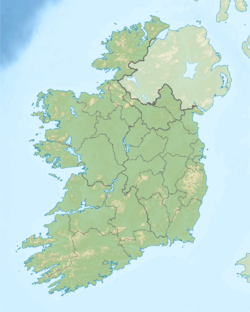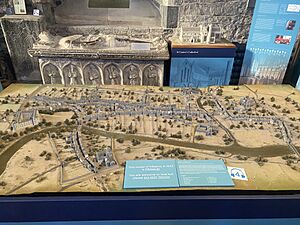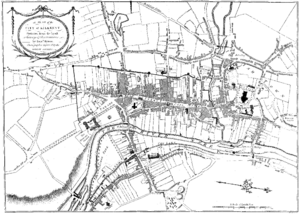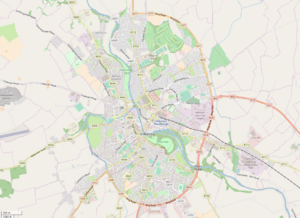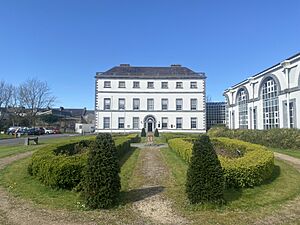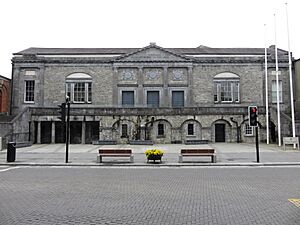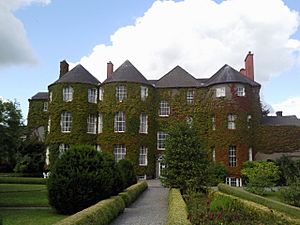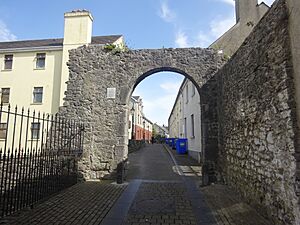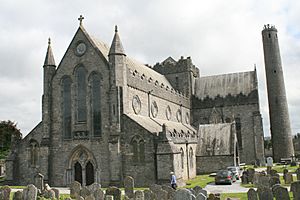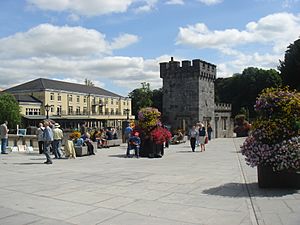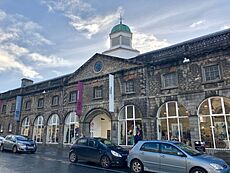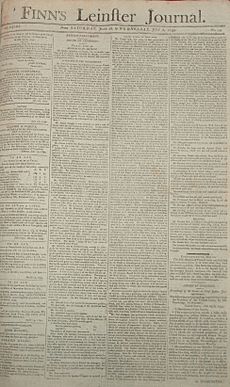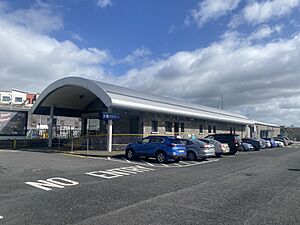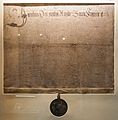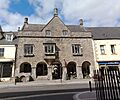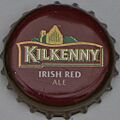Kilkenny facts for kids
Quick facts for kids
Kilkenny
Cill Chainnigh
|
||
|---|---|---|
|
City
|
||
|
|
||
|
||
| Nickname(s):
The Marble City
|
||
| Country | Ireland | |
| Province | Leinster | |
| County | Kilkenny | |
| Elevation | 60 m (200 ft) | |
| Population | 27,184 | |
| • Rank | 13th | |
| Demonym(s) | Cat | |
| Time zone | UTC±0 (WET) | |
| • Summer (DST) | UTC+1 (IST) | |
| Eircode routing key |
R95
|
|
| Telephone area code | +353(0)56 | |
| Irish Grid Reference | S506563 | |
Kilkenny (Irish: Cill Chainnigh [ˌciːl̠ʲ ˈxan̠ʲəj]) is a historic city in County Kilkenny, Ireland. Its name means 'church of Cainnech'. The city is located in the South-East Region and the province of Leinster. It sits on both sides of the River Nore. In 2022, Kilkenny had a population of 27,184, making it the 13th largest urban area in Ireland.
Kilkenny is a popular place for tourists. It has many old buildings like Kilkenny Castle, St Canice's Cathedral with its round tower, and Rothe House. The city is also known for its craft shops, the Watergate Theatre, beautiful gardens, and museums. Every year, Kilkenny hosts fun events like the Kilkenny Arts Festival, the Cat Laughs comedy festival, and the Kilkenny Roots music festival.
The city started as a church settlement in the early 500s. After the Norman invasion of Ireland in the 1100s, Kilkenny Castle and city walls were built. This helped protect the people living in what became a busy Norman trading town. In 1207, William Marshall gave Kilkenny a special charter, making it a town. By the late 1200s, Norman-Irish people controlled Kilkenny. In 1609, King James I of England officially made Kilkenny a city. Later, during the Irish Rebellion of 1641, the "Confederation of Kilkenny" was based here. Kilkenny is also famous for its brewing history and is often called The Marble City. People from Kilkenny are sometimes called 'Cats'.
Contents
- Discovering Kilkenny's Name
- A Journey Through Kilkenny's Past
- Kilkenny's Location and Weather
- Kilkenny's People and Languages
- How Kilkenny is Governed
- Famous Places in Kilkenny
- Kilkenny's Culture and Arts
- Kilkenny's Infrastructure
- Sports in Kilkenny
- Famous People from Kilkenny
- Images for kids
- See also
Discovering Kilkenny's Name
Kilkenny's name comes from the Irish words Cill Chainnigh. This means 'Cell' or 'Church of Cainneach or Canice'. The name refers to a church built to honor St. Canice. This church was on the hill where St. Canice's Cathedral and its round tower stand today. This area was likely the first main settlement. The old round tower shows that a church was here very early on.
The Annals of the Four Masters, a historical record, first mentioned Kilkenny in 1085. Before this, the area was known as Osraighe. This name referred to the whole region or its main town. The Four Masters record was the first time the main town was called Ceall-Cainnigh, which is now Kilkenny.
A Journey Through Kilkenny's Past
Kilkenny began as a church settlement in the early 500s. A church was built to honor St. Canice, which later became St. Canice's Cathedral. This church was a very important religious center from at least the 700s. The first mention of Cill Chainnigh in historical records was in 1085. Evidence also shows that people lived in the area even earlier, during the Mesolithic and Bronze Age periods. You can find out more about Kilkenny's history from old newspapers, photos, letters, and archaeological finds. One important old book is Liber Primus Kilkenniensis, which dates back to the 1200s.
The Kings of Ossory, like the O'Carrolls and Fitzpatricks, lived around Cill Chainnigh. The main church for the Kingdom of Osraige moved from Aghaboe to Cill Chainnigh. After the Norman invasion of Ireland, Richard Strongbow, a powerful Norman lord, built a castle near where Kilkenny Castle is today. William Marshall then started to develop the town of Kilkenny. He built walls to protect the people living there. By the late 1200s, Norman-Irish people controlled Kilkenny. The old church area at St. Canice's Cathedral became known as Irishtown. The new Norman town inside the walls was called Hightown.
Kilkenny was the location of Ireland's first recorded witch trial in 1324. This event was started by the Bishop of Ossory, Richard de Ledrede. It involved a woman named Dame Alice de Kyteler and her servant Petronella de Meath. Petronella became the first person in Ireland to be burned for witchcraft. Dame Alice is believed to have left the country. This trial is one of the earliest recorded witch burnings in Europe and has led to many local stories about the ghosts of Alice and Petronella. Alice's old house, Kyteler's Inn, is still a pub today.
The Black Death, a terrible plague, greatly affected the Norman-Irish people in Kilkenny in 1348. In 1367, the Statutes of Kilkenny were passed in the city. These laws aimed to stop the decline of Norman rule in Ireland. In 1609, King James I of England gave Kilkenny a special Royal Charter, making it a city. After the Irish Rebellion of 1641, a group called the Irish Catholic Confederation (also known as the "Confederation of Kilkenny") was based in the city. This group lasted until the Cromwellian conquest of Ireland in 1649. James II of England stayed in Kilkenny Castle for several months in 1689-1690.
Stephens Barracks, a military base, was built between 1800 and 1803. The Kilkenny Design Workshops opened in 1965. In 1967, the Marquess of Ormonde gave Kilkenny Castle to the people of Kilkenny. Today, the city has a lively cultural scene. It hosts annual events like the Kilkenny Arts Week Festival in August and the Cat Laughs Comedy Festival in June. Kilkenny is also where the Irish ale, Smithwick's, was first brewed.
Kilkenny's Location and Weather
Where is Kilkenny Located?
Kilkenny is in the Nore Valley, built on both sides of the River Nore. It is in the center of County Kilkenny in the province of Leinster, in the south-east of Ireland. The city is about 117 kilometers (73 miles) from Dublin, the capital. It is 48 kilometers (30 miles) north of Waterford, the nearest city. Kilkenny is 80 kilometers (50 miles) south-east of Wexford and 122 kilometers (76 miles) west of Limerick. The city is about 60 meters (197 feet) above sea level. The area of Kilkenny city is 3.74 square kilometers (1.44 square miles).
What is Kilkenny's Climate Like?
| Weather chart for Kilkenny | |||||||||||||||||||||||||||||||||||||||||||||||
|---|---|---|---|---|---|---|---|---|---|---|---|---|---|---|---|---|---|---|---|---|---|---|---|---|---|---|---|---|---|---|---|---|---|---|---|---|---|---|---|---|---|---|---|---|---|---|---|
| J | F | M | A | M | J | J | A | S | O | N | D | ||||||||||||||||||||||||||||||||||||
|
78
8
2
|
66
9
2
|
68
11
3
|
56
13
4
|
60
16
7
|
61
18
9
|
55
20
11
|
78
20
11
|
69
18
9
|
95
14
7
|
80
11
4
|
90
9
2
|
||||||||||||||||||||||||||||||||||||
| temperatures in °C precipitation totals in mm |
|||||||||||||||||||||||||||||||||||||||||||||||
|
Imperial conversion
|
|||||||||||||||||||||||||||||||||||||||||||||||
Kilkenny has a changeable oceanic climate, similar to the rest of Ireland. This means it has mild temperatures and few extreme weather events. It is a temperate oceanic climate, or Cfb in the Köppen climate classification system. Kilkenny is in plant Hardiness zone 9. The city is located inland and surrounded by hills, which protects it from strong winds. The strongest wind gust recorded was 77 knots (143 km/h or 89 mph) on January 12, 1974.
Kilkenny often records some of the highest summer and lowest winter temperatures in Ireland. The highest air temperature ever recorded in Ireland was 33.3 °C (91.9 °F). This happened at Kilkenny Castle on June 26, 1887. The Met Éireann Kilkenny Weather Observing Station collected weather data from 1957 to 2008. The highest temperature recorded there was 31.5 °C (88.7 °F) on June 29, 1976. The lowest air temperature was -14.1 °C (6.6 °F) on January 2, 1979.
The warmest and sunniest month on record in Kilkenny was August 1995. It had 274.9 hours of sunshine and very high temperatures. The most sunshine in one day was 16.3 hours on June 18, 1978. Temperatures have generally been rising, especially since 1988. Annual temperatures are now about 0.5 degrees Celsius (0.9°F) higher than 20th-century levels. The most rainfall in one day was 66.4 mm (2.61 in) on July 17, 1983. Rainfall has been increasing steadily since 2005, with 2009 being the wettest year since records began in 1958.
| Climate data for Kilkenny Weather Observing Station 1978–2007 (Extremes June 1957 to April 2008) | |||||||||||||
|---|---|---|---|---|---|---|---|---|---|---|---|---|---|
| Month | Jan | Feb | Mar | Apr | May | Jun | Jul | Aug | Sep | Oct | Nov | Dec | Year |
| Record high °C (°F) | 14.1 (57.4) |
15.9 (60.6) |
19.2 (66.6) |
23.5 (74.3) |
26.0 (78.8) |
31.5 (88.7) |
31.4 (88.5) |
30.8 (87.4) |
26.6 (79.9) |
23.7 (74.7) |
17.5 (63.5) |
15.5 (59.9) |
31.5 (88.7) |
| Mean daily maximum °C (°F) | 8.2 (46.8) |
8.6 (47.5) |
10.6 (51.1) |
12.9 (55.2) |
15.7 (60.3) |
18.2 (64.8) |
20.3 (68.5) |
20.2 (68.4) |
17.8 (64.0) |
14.1 (57.4) |
10.8 (51.4) |
8.8 (47.8) |
13.8 (56.8) |
| Daily mean °C (°F) | 4.9 (40.8) |
5.2 (41.4) |
6.9 (44.4) |
8.5 (47.3) |
11.1 (52.0) |
13.8 (56.8) |
15.8 (60.4) |
15.6 (60.1) |
13.4 (56.1) |
10.3 (50.5) |
7.3 (45.1) |
5.6 (42.1) |
9.9 (49.8) |
| Mean daily minimum °C (°F) | 1.6 (34.9) |
1.9 (35.4) |
3.2 (37.8) |
4.2 (39.6) |
6.5 (43.7) |
9.3 (48.7) |
11.3 (52.3) |
11.0 (51.8) |
9.1 (48.4) |
6.5 (43.7) |
3.7 (38.7) |
2.4 (36.3) |
5.9 (42.6) |
| Record low °C (°F) | −14.1 (6.6) |
−11.1 (12.0) |
−7.9 (17.8) |
−5.4 (22.3) |
−3.7 (25.3) |
0.5 (32.9) |
2.3 (36.1) |
1.2 (34.2) |
−1.6 (29.1) |
−4.8 (23.4) |
−7.0 (19.4) |
−10.8 (12.6) |
−14.1 (6.6) |
| Average rainfall mm (inches) | 78.3 (3.08) |
66.1 (2.60) |
67.9 (2.67) |
56.4 (2.22) |
60.4 (2.38) |
61.0 (2.40) |
54.6 (2.15) |
77.8 (3.06) |
69.0 (2.72) |
95.3 (3.75) |
80.2 (3.16) |
90.4 (3.56) |
857.4 (33.76) |
| Average rainy days (≥ 1 mm) | 13 | 12 | 12 | 10 | 11 | 10 | 9 | 10 | 10 | 13 | 12 | 13 | 135 |
| Average snowy days | 3.6 | 3.6 | 2.5 | 0.8 | 0.1 | 0.0 | 0.0 | 0.0 | 0.0 | 0.0 | 0.1 | 2.0 | 12.8 |
| Average relative humidity (%) | 79.5 | 74.3 | 69.2 | 63.6 | 63.4 | 65.9 | 65.2 | 65.1 | 67.5 | 74.2 | 78.9 | 81.8 | 70.7 |
| Mean monthly sunshine hours | 55.8 | 64.4 | 99.2 | 147.0 | 173.6 | 147.0 | 145.7 | 145.7 | 124.0 | 93.0 | 66.0 | 49.6 | 1,314 |
| Mean daily sunshine hours | 1.8 | 2.3 | 3.2 | 4.9 | 5.6 | 4.9 | 4.7 | 4.7 | 4.0 | 3.0 | 2.2 | 1.6 | 3.6 |
| Source: Met Éireann | |||||||||||||
Kilkenny's People and Languages
How Many People Live in Kilkenny?
| Historical population | ||
|---|---|---|
| Year | Pop. | ±% |
| 1821 | 23,230 | — |
| 1831 | 23,741 | +2.2% |
| 1841 | 19,071 | −19.7% |
| 1851 | 15,257 | −20.0% |
| 1861 | 13,235 | −13.3% |
| 1871 | 12,710 | −4.0% |
| 1881 | 12,299 | −3.2% |
| 1891 | 11,048 | −10.2% |
| 1901 | 10,609 | −4.0% |
| 1911 | 19,514 | +83.9% |
| 1926 | 10,046 | −48.5% |
| 1936 | 10,237 | +1.9% |
| 1946 | 10,291 | +0.5% |
| 1951 | 10,572 | +2.7% |
| 1956 | 12,328 | +16.6% |
| 1961 | 12,081 | −2.0% |
| 1966 | 12,030 | −0.4% |
| 1971 | 13,306 | +10.6% |
| 1981 | 16,886 | +26.9% |
| 1986 | 17,517 | +3.7% |
| 1991 | 17,669 | +0.9% |
| 1996 | 18,696 | +5.8% |
| 2002 | 20,735 | +10.9% |
| 2006 | 22,179 | +7.0% |
| 2011 | 24,423 | +10.1% |
| 2016 | 26,512 | +8.6% |
| 2022 | 27,184 | +2.5% |
Most of Kilkenny's population lives just outside the city's official boundary. In 2022, the urban area of Kilkenny had a population of 27,184 people. In 2006, the Kilkenny Town Borough had 8,661 people, a small increase from 2002. The areas surrounding the town had 13,518 people, a larger increase. Overall, the population of Kilkenny and its surrounding areas was 22,179 in 2006. People from Kilkenny are often called 'Cats'.
What Languages and Religions are in Kilkenny?
Kilkenny is a multilingual place, meaning many languages are spoken. However, most people speak English. Irish is the second most common language. In recent years, with more people moving to Ireland, many other languages have become common in Kilkenny. The main religion in Kilkenny is Catholicism. However, there are also followers of the Church of Ireland, Presbyterian, Methodist, Jewish, and other religions living in the city.
How Kilkenny is Governed
Kilkenny is now managed as part of County Kilkenny. The local area of Kilkenny elects 7 out of 24 members to the Kilkenny County Council. This area is known as the Municipal District of Kilkenny City. Local government in Kilkenny is responsible for things like planning, roads, sanitation, and libraries. These duties are guided by laws like the Local Government Acts.
Kilkenny's first council was chosen in 1231. From the 1200s to the late 1500s, the main leader was called the sovereign. After that, they were called the mayor. In 1609, King James I of England gave Kilkenny a royal charter, making it a city. This charter included the area of Irishtown. In 2014, the city's borough council was merged with the Kilkenny County Council.
Kilkenny County is part of the Southern Region of Ireland. It is also part of the Carlow–Kilkenny area for national elections. For European Parliament elections, it is part of the South constituency.
Is Kilkenny Still a City?

The term "city" for Kilkenny is important to its people. Historically, being a city in Ireland (and the UK) was a special title given by the king or queen. It brought more prestige than being a "borough" or "town". Often, a place was called a city if it had a cathedral. This is why some very small places like Wells or St Davids are called cities. In modern Irish law, a city has specific legal powers for its local government. Since 1840, Kilkenny has not been managed as a city under local government law.
However, in 2002, a law was passed that recognized Kilkenny's historic city status. Local politicians successfully argued that Kilkenny should still be called a "city". So, the law states that the description "city" can still be used for Kilkenny. Even though it is now managed as a municipal district, it is officially called "the Municipal District of Kilkenny City". This means it is still common and allowed by law to call Kilkenny a city.
Famous Places in Kilkenny

Kilkenny has many important historical buildings and landmarks. It is a well-preserved medieval town. Kilkenny Castle and St. Canice's Cathedral with its round tower are the most famous. The city's medieval walls still exist in parts. These walls show how big and important the town was in the Middle Ages. Kilkenny grew from a church settlement into a busy Norman trading town. St. Canice's Cathedral and its round tower are examples of the early church settlement.
Rothe House on Parliament Street is a great example of an Elizabethan merchant's townhouse. It is on the only fully preserved medieval land plot in Ireland. It also has a restored 17th-century garden behind the house. This garden has herbs, vegetables, and an orchard.
The black stone with white fossils, called Kilkenny marble, was used in many of Kilkenny's beautiful buildings. This stone was dug up locally, especially from a quarry south of the town. Kilkenny marble was even used for the base of King Richard III's new tomb in England.
Places to visit in Kilkenny include Kilkenny Castle and Gardens (with the Butler Gallery), St. Canice's Cathedral and round tower, Rothe House and Garden, Shee Alms House, Kilkenny Courthouse, St. Mary's Cathedral, The Tholsel, the Dominican Black Abbey, St. John's Church, Butler House, and St. Francis Abbey Brewery. Gardens to explore include the Castle Rose Garden, Rothe House Garden, and the Famine Memorial Garden. In the wider county, you can visit Kells Priory, Jerpoint Abbey, Dunmore Caves, and Jenkinstown Park. Kilkenny is called the "Marble City" because of the local black marble used in its buildings.
Kilkenny Castle and City Walls
Kilkenny Castle was once the home of the Butler family. In the mid-1900s, it was sold for £50 to a local committee. Soon after, it was given to the Irish State. The castle has been restored and is now open to visitors. Some art from the National Art Gallery is shown inside. The castle has beautiful gardens on its northwest side and large grounds in front. It is now one of the most visited tourist spots in Ireland.
The first stone castle was started in 1204 by William Marshall and finished in 1213. It was a symbol of Norman rule and an important part of the town's defenses. It was a square castle with four large round towers at each corner and a big ditch. Three of these original towers still stand today.
The Kilkenny Walls protected the medieval town. The town was surrounded by walls with towers and gates. Parts of these walls still exist, like Talbot Tower (built in 1207). This is the larger of the two remaining towers from the medieval High town defenses. There are also walls on Abbey Street, and the nearby Black Freren Gate is the only remaining gate into the old city. Another wall runs through the brewery grounds next to St. Francis Abbey. There is a plan to protect and preserve the city's walls for the future.
St. Canice's Cathedral and Tower
St Canice's Cathedral, also called Kilkenny Cathedral, was built in the 1200s. It is the second longest cathedral in Ireland. The cathedral is named after Saint Canice, who also gave his name to the town. The cathedral has a cross shape and was built in the Early English style. It is made of limestone with a low central tower supported by black marble columns. The outside walls have battlements, and there are two small spires at the west end. The cathedral is about 68 meters (75 yards) long and 37 meters (41 yards) wide at the transepts.
Next to the cathedral is a 30-meter (100-foot) tall 9th-century round tower. St. Canice's tower is a great example of an old, well-preserved Christian round tower. You can only reach the top by climbing steep internal ladders. It might have been used as a watchtower and a safe place. From the top, you get a good view of Kilkenny and the countryside. The hill where the cathedral stands is thought to be where the first major settlement in Kilkenny was. The round tower suggests that a church was established there very early on.
The Dominican Black Abbey was founded in 1225 and is located just off Parliament Street.
Kilkenny's Bridges
Kilkenny has four main bridges: Green's Bridge, John's Bridge, the Ossory Bridge, and the St Francis Bridge. There are also two bridges just for people walking or cycling: the Lady Desart Bridge and the Ossory Pedestrian Bridge. All these bridges cross the River Nore.
Green's Bridge, also known as the 'Great Bridge of Kilkenny', crosses the River Nore in St. Canices Parish. It was first built before 1200 but has been rebuilt many times because of floods. Major floods happened in 1487 and 1763. The current bridge was built in 1766 after the 'Great Flood of 1763'. It was designed by George Smith and built by William Colles.
John's Bridge connects John Street to Rose Inn Street. It was also first built after 1200 and has been called 'John's Bridge' since the Middle Ages. Like Green's Bridge, it has been rebuilt many times due to floods. During the 1763 flood, people gathered on John's Bridge after Green's Bridge collapsed. Then, John's Bridge also collapsed, and sixteen people died. The current John's Bridge was finished in 1910. It spans 43 meters (140 feet) across the River Nore. At the time, it was said to be the longest single-span reinforced bridge in Ireland or Britain.
The Ossory Bridge, part of the ring road, was completed in 1984 and has a sculpture built into it. The St Francis Bridge opened in May 2017 as part of the Kilkenny Central Access Scheme. This new bridge project caused some debate and protests in Kilkenny in 2014.
The Lady Desart Bridge and Ossory Pedestrian bridge are for walkers and cyclists. The Lady Desart Bridge opened in January 2014. It connects John's Quay and Bateman Quay, located between John's Bridge and Green's Bridge. The Ossory Pedestrian bridge is under the main Ossory bridge. It links the Canal Walk on one side of the River Nore to the Lacken Walk on the other side.
Old Woollen Mills
The Old Woollen Mills were built in the 1800s on Bleach Road, north of the city. It was once one of the biggest employers in the area. The site covers 8,361 square meters (90,000 sq ft) and has over a mile of river frontage along the Nore. One of its notable features is a tall red brick chimney, built in 1905. Today, a business called Kilkenny Architectural Salvage, which sells architectural items and antiques, is located on the site.
Kilkenny's Culture and Arts
Kilkenny is a popular place for tourists in the South-East Region of Ireland. Its art galleries, historical buildings, craft shops, theatre, comedy shows, public gardens, and museums are some of the main reasons people visit. It's also a good base to explore the countryside nearby.
Important cultural sites include Kilkenny Castle, St. Canice's Cathedral and round tower, Rothe House, St. Mary's Cathedral, Kells Priory, Kilkenny Town Hall, Black Abbey, and Butler Gallery. The Butler Gallery moved to a new location in Evan's Home in August 2020.
Festivals and Events in Kilkenny
Kilkenny hosts many festivals throughout the year.
The Kilkenny Tradfest happens during the St. Patrick's Day weekend in March. It includes the St. Patrick's Day parade and a music festival that celebrates traditional Irish and folk music.
The Kilkenny Roots Festival takes place on the first weekend of May. It features Americana, Bluegrass, Folk, Rockabilly, and Alt-Country artists. These musicians perform in various indoor venues across the city. Since 1998, the festival has brought in many famous artists from the Americana/Roots music style.
Kilkenny also hosts the annual Cat Laughs comedy festival every June bank holiday week.
The Kilkenny Arts Festival, started in the 1970s, happens in late August. During this time, Kilkenny becomes a hub for contemporary art. There are theatre, dance, visual art, literature, film, painting, sculptures, and live performances. Music events, including traditional, classical, world music, and jazz, are also part of the festival.
Savour Kilkenny is a food festival held every October. In November, Kilkenny puts on Kilkenomics, which is the world's first festival combining economics and comedy. Venues like the Watergate Theatre offer a variety of shows, including plays, music, opera, and dance. They also have art and photography exhibitions.
Music Scene in Kilkenny
Kilkenny is home to many music groups, including traditional Irish musicians and bands like Kerbdog and Engine Alley. Other groups include R.S.A.G., whose album Organic Sampler was nominated for the Irish Album of the Year in 2008. Some pubs have regular Irish traditional music sessions. The Kilkenny Roots Festival is held every May Bank Holiday weekend.
Kilkenny is even mentioned in songs, like "When You Danced With Me" from ABBA's 2021 album Voyage.
The Kilkenny Arts Festival is held every August. A large concert called 'Source' takes place at Nowlan Park. Famous musicians like Rod Stewart, Shania Twain, Bob Dylan, and Dolly Parton have performed there. Bruce Springsteen played two nights in July 2013.
St Canice's Cathedral sometimes hosts classical musicians and choirs. The Kilkenny Choir and a gospel choir perform in churches around the town. Cleere's pub and theatre on Parliament Street are known for hosting Irish and international bands, including indie, jazz, and blues. They also have a traditional music session every Monday night.
Theatre in Kilkenny
Kilkenny has a long history of theatre, dating back to 1366. In 1645, Henry Burkhead printed a play in Kilkenny called Cola's Fury, or Lirenda's Misery. This play was about the Irish Rebellion of 1641. In 1802, Sir Richard and Sir John Power started the Kilkenny Private Theatre.
The Watergate Theatre in Kilkenny is a major center for performing and visual arts. It offers a varied program of professional and amateur plays, classical and modern music, opera, and dance. It also hosts exhibitions of paintings and photographs. The Set Theatre is a smaller theatre located on John Street.
Film Industry in Kilkenny
The award-winning animation studio Cartoon Saloon is based in Kilkenny. Film production companies like Young Irish Film Makers and Mycrofilms are also located here. Kilkenny has hosted the Subtitle European Film Festival every November since 2012.
Media in Kilkenny
Radio Stations
KCLR is a radio station that serves both Carlow and Kilkenny. Its main offices are in Kilkenny and Carlow. KCLR broadcasts on 96FM and is an independent local radio station. In 2009, KCLR reached 60% of listeners each week.
Before KCLR, there was Radio Kilkenny. It started as a pirate station called Kilkenny Community Radio. In 1988, it got a license to broadcast to Kilkenny city and county. Radio Kilkenny was very popular in County Kilkenny. However, it lost its license in 2003 when the area it covered was changed to include Carlow. The station stopped broadcasting on January 1, 2004.
Beat 102-103 is a regional radio station for young people. It broadcasts across the South East of Ireland. It reaches about 450,000 people and was very popular in the region in 2006.
Newspapers
Newspapers have been printed in Kilkenny for centuries. Some old examples include Finns Leinster Journal (1767–1965), the Kilkenny People (1916–1992), and the Kilkenny Moderator (1814–1916). Other papers included the Leinster Independent, the Kilkenny Chronicle, and the Kilkenny Express.
Finn's Leinster Journal was started by Edmund Finn in 1767. It was published in Kilkenny but also covered news from Carlow. It later became the Leinster Journal and then the Kilkenny Journal.
The Moderator newspaper changed its name to Kilkenny Moderator from 1822 to 1919.
The modern Kilkenny People newspaper was first published in 1895. It is a weekly paper. In 2006, the Kilkenny People sold about 17,578 copies each week. It is printed by the Kilkenny People Group, which also publishes other regional newspapers.
Photography Collections
There are many historical photo collections of Kilkenny. These include the Lawrence Collection from around 1900, the Crawford Collection from around 1940, and the Valentine Collection from around 1950. There are also many old postcards of the city.
Community Spirit
Awards for Kilkenny
In 2008, Kilkenny was named the Academy of Urbanism European Great Town. The chairman, John Thompson, praised Kilkenny for growing economically while keeping its unique character and humor. Kilkenny also won the Irish Tidy Towns Competition in 1985.
Sister Cities
Kilkenny is twinned with several cities around the world. These include Moret-sur-Loing in France, Formigine in Italy, and a town also named Kilkenny in Minnesota in the United States.
Kilkenny's Infrastructure
Schools and Learning
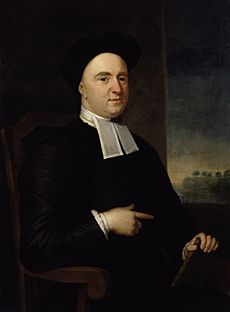
Kilkenny has many well-known secondary schools. One of the oldest schools in the country is the Church of Ireland Kilkenny College, founded in 1538. Famous past students include Jonathan Swift and George Berkeley. George Berkeley, a great philosopher, studied at Kilkenny College from 1696 to 1700.
St. Kieran's College was founded in 1782. It was the first Roman Catholic secondary school in Ireland. It opened after laws against Irish Catholics were relaxed. Other secondary schools include Loreto Secondary School, CBS Kilkenny, Coláiste Pobail Osraí, Presentation College, and Kilkenny City Vocational School. Schools in the county include Castlecomer Community School and Colaiste Mhuire Johnstown. These schools are also known for their focus on hurling and camogie. Gaelscoil Osraí is an Irish-speaking school in Kilkenny. It is the second largest Irish-only school in Ireland, with about 450 students.
Maynooth University had a campus at St. Kieran's College from 1997 to 2018. Students could study their first year of arts degrees in Kilkenny before moving to the main campus in Maynooth.
Roads Connecting Kilkenny
Major national roads serving Kilkenny include the N10. This road connects to the M9 motorway, which goes to Dublin, Carlow, and Waterford. The N77 connects to Portlaoise and the M7 motorway. The N76 connects to Clonmel.
Railway Connections
Kilkenny railway station opened on May 12, 1848. Kilkenny gained railway links to Dublin in 1850 and Waterford in 1854. The station was renamed McDonagh Station in 1966 after the Irish nationalist Thomas MacDonagh. Kilkenny is a stop on Iarnród Éireann's Intercity route between Dublin and Waterford.
From Kilkenny station, trains run on the Dublin–Waterford railway line. You can connect in Waterford to trains going to Clonmel and other stations. At Kildare, connecting trains link to many other towns across Ireland.
Air Travel
Kilkenny Airport is only used for private flights. The closest airports with regular flights are Dublin Airport and Cork Airport. Both are about 150 kilometers (93 miles) away.
Industries in Kilkenny
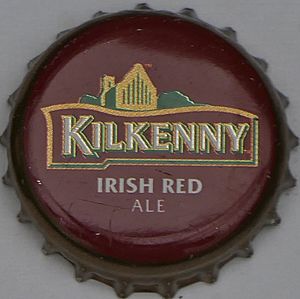
Kilkenny has a long history of brewing. The St. Francis Abbey Brewery was founded in the early 1700s. Guinness Ireland Group owned this brewery from the 1960s. Later, it became part of Diageo, a large alcoholic beverage company. In its final years, only a small amount of Smithwick's Ale was made there. Another product was Kilkenny ale. About 80% of the beer made was Budweiser, which Diageo produced under license. Diageo announced in 2008 that the St. Francis Abbey Brewery would close. It closed on December 31, 2013, and production moved to Dublin.
Dairy Cooperatives
Kilkenny is also home to the main offices of Glanbia. This is one of the world's top dairy companies. Glanbia was formed when two dairy businesses, Avonmore and Waterford Foods, merged. It has operations in Ireland, the UK, the US, and over 30 other countries.
In 1966, many small local creameries in County Kilkenny joined together to create the Avonmore Creameries brand. This cooperative became Avonmore Food plc in 1988 and then joined with Waterford Food plc in 1997. Today, it is known as Glanbia, a global food company. Glanbia has its roots in the Irish agricultural cooperative movement, which started over a century ago. Today, Glanbia operates in 34 countries and exports to over 100 countries worldwide.
Other Businesses
New developments in Kilkenny have brought more investment from local businesses and attracted new industries. Leggetsrath Business Park opened in 2003. Kilkenny also has two retail parks: Kilkenny Retail Park and Ormonde Retail Park. Hebron Business Park, built in 2002, is an extension to the main industrial area in Kilkenny.
Hospitals in Kilkenny
Kilkenny has three public hospitals and one private hospital. St. Luke's is a general hospital built in 1942. It offers medical, surgical, maternity, and children's services. St. Canice's is a psychiatric hospital, opened in 1852. It provides mental health services, including acute care and addiction counseling. Kilcreene is the regional hospital for bone and joint problems. Aut Even is a private hospital located outside Kilkenny City.
Sports in Kilkenny
Athletics
The Kilkenny City Harriers Club is an athletics club started in 1953. In 1989, Kilkenny was chosen as a local sports center. An all-weather running track and facilities were built to meet international standards. In 1992, the new track was officially opened and named Scanlon Park.
Gaelic Games (GAA)
The main office and grounds for Kilkenny GAA are at Nowlan Park in the city. The Kilkenny branch of the GAA was founded in 1887.
Hurling is the most popular sport in Kilkenny. The county hurling team is one of the most successful in Ireland. Secondary schools like St. Kieran's College and Christian Brothers School (CBS) are known for their strong hurling teams. Famous hurlers like Eddie Keher, Brian Cody, and Henry Shefflin played for St. Kieran's. There are three GAA clubs in the city: O'Loughlin Gaels GAA, Dicksboro GAA, and James Stephens (GAA Club).
Gaelic football is also played in Kilkenny, but it is not as popular as hurling. The Kilkenny football team is the only county not to take part in the All-Ireland Senior Football Championship.
Soccer (Association Football)
Kilkenny City AFC played in the League of Ireland until January 2008. The club left the league due to "lack of money, poor results and low attendance". The Kilkenny and District Soccer League organizes leagues for schoolboys, youth, and junior players throughout the county.
In 2015, Kilkenny United W.F.C. joined the Women's National League. This is the top league for women's soccer in Ireland.
Rugby
Kilkenny RFC was founded in 1885. It is a rugby union club based at Foulkstown. The club has produced several players for the Ireland national team, including Willie Duggan and Gary Halpin. Ian Dowling played for the Munster Rugby team and won the European Rugby Cup twice.
Rugby is also played in schools like Kilkenny College and Kilkenny Christian Brothers School (CBS).
Golf
Kilkenny Golf Club is an 18-hole championship course located in the northwest of the city. It has hosted several professional golf events. The course is mostly flat and has many trees. It can be played all year round because of its sand-based greens.
Near Kilkenny City, there is also a Driving Range in Newpark and an 18-hole Par 3 golf course in Pocoke. Mount Juliet Golf Course is a famous golf resort near Kilkenny in Thomastown. Jack Nicklaus designed the course, and it is considered one of Ireland's best.
Cycling
Kilkenny has two cycling clubs linked to Cycling Ireland: Kilkenny Pedallers and Marble City Cyclers. Since 2016, Kilkenny has been the base for Rás na mBan. This is a women's cycling event with six stages over five days, covering over 400 kilometers (249 miles).
Ice Hockey
Kilkenny City Storm is a mixed ice hockey team formed in 2007. They play in the Irish Ice Hockey Association Recreational Division League. The team also has an inline hockey team that plays in the Northern Inline Hockey League and the Irish inline hockey league.
Famous People from Kilkenny
In his book Kilkenny: The Landed Gentry & Aristocracy, Art Kavanagh writes about eighteen of the most important families from Kilkenny. These families were chosen from different parts of the county. Some of these notable families include the Agars of Gowran, the Blundens of Castle Blunden, and the Butlers of Maidenhall. Other well-known families are the Cuffes (Lords Desart), the Floods of Farmley, and the Smithwicks of Kilcreene.
Images for kids
See also
 In Spanish: Kilkenny para niños
In Spanish: Kilkenny para niños








